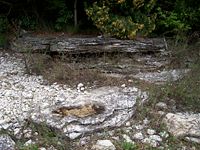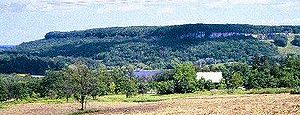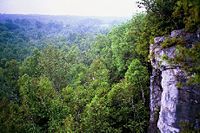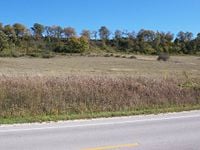Niagara Escarpment
The Niagara Escarpment is a long escarpment or cuesta in the United States and Canada that runs westward from New York State, through Ontario, Michigan, Wisconsin and Illinois. It is composed of the Lockport geological formation of Silurian age, and is similar to the Onondaga geological formation, which runs parallel to it and just to the south, through the western portion of upstate New York and southern Ontario. The escarpment is most famous for the cliff over which the Niagara River forms Niagara Falls, for which it is named.
The Niagara Escarpment is the most prominent of several escarpments formed in the bedrock of the Great Lakes. It is traceable from its easternmost point in New York State, starting well east of the Genesee River Valley near Rochester, creating waterfalls on the river in that city, thence running westwards to the Niagara River forming a deep gorge between Lewiston, New York and Queenston, Ontario. In Southern Ontario it stretches along the Niagara Peninsula hugging close to the Lake Ontario shore through the cities of St. Catharines and Hamilton where it takes a sharp turn north toward Georgian Bay. It then follows the Georgian Bay shore northwestwards to form the spine of the Bruce Peninsula, Manitoulin, St. Joseph Island and other islands located in northern Lake Huron where it turns westerwards into the Upper Peninsula of northern Michigan, south of Sault Ste. Marie. It then extends southwards into Wisconsin following the Door Peninsula and then more inland from the western coast of Lake Michigan and Milwaukee ending northwest of Chicago near the Wisconsin-Illinois border.
Formation

Study of rock exposures and drillholes demonstrates that there is no displacement of the rock layers at the escarpment: this is not a fault line but the result of unequal erosion. The Niagara Escarpment has a caprock of dolomitic limestone ("dolostone") which is more resistant and overlies weaker, more easily eroded shale as a weathering-resistant "cap." In other words, the escarpment formed over millions of years through a process of differential erosion of rocks of different hardnesses. Through time the soft rocks weather away or erode by the action of streams. The gradual removal of the soft rocks undercuts the resistant caprock, leaving a cliff or escarpment. The erosional process is most readily seen at Niagara Falls, where the river has quickened the process. It can also be seen on the three waterfalls of the Genesee River at Rochester, New York (additional resistant rock layers make more than one escarpment in some places). Also, in some places thick glacial deposits conceal the Niagara Escarpment, such as north of Georgetown, Ontario, where it actually continues under glacial till and reappears farther north.
The dolostone cap was laid down as sediment on the floor of a marine environment. In Michigan, behind the escarpment, the cuesta capstone slopes gently to form a wide basin, the floor of an Ordovician-Silurian tropical sea. There the constant depositing of minute shells and fragments of biologically-generated calcium carbonate, mixed with sediment washing in by erosion of the virtually lifeless landmasses eventually formed a limestone layer. In the Silurian some magnesium substituted for some of the calcium in the carbonates, slowly forming harder sedimentary strata in the same fashion. Worldwide sea levels were at their all-time maximum in the Ordovician; as the sea retreated, erosion inevitably began.
Human geography
The Welland Canal allows ships to traverse the Escarpment between Lake Erie and Lake Ontario on the Niagara Peninsula of Ontario. The escarpment was a major obstacle in the construction of the Erie Canal in New York and was traversed by a series of locks; the community which grew up at the site thus became known as Lockport, New York.
In Southern Ontario, the Bruce Trail runs the length of the escarpment from Queenston (Niagara Peninsula) to Tobermory (Bruce Peninsula).
Hamilton, Ontario is situated on the escarpment in such a way that the north end of the city is below and the south part above. Affectionately referred to as "the mountain" by its residents, the escarpment is both an attraction and a hindrance to everyday life. Bridging the divide are a number of roads or "mountain accesses" that separate the urban core below from the suburban expansion above.
Vineyard land
On the Canadian side of the border the Niagara Escarpment is a group-sub-appellation comprising the Short Hills Bench, The 20 Mile Bench and the Beamsville Bench. On the US side of the border the name defines an American Viticultural Area.
World Biosphere Reserve
In February 1990, the Niagara Escarpment was designated a World Biosphere Reserve by UNESCO, making it one of 12 in Canada. Development and land use adjacent to the escarpment is regulated and the biosphere protected by the Niagara Escarpment Commission, an agency of the Ontario government.
See also
- Ontario Greenbelt
- Oak Ridges Moraine
External links
- Niagara Escarpment Commission
- Escarpment Coalition
- Escarpment Interprative Centre
- Lockport formation diagrams and rocks
- Wisconsin Geology Page- Niagara Escarpment
- Student level description of Niagara Escarpment, Includes animations.
Credits
New World Encyclopedia writers and editors rewrote and completed the Wikipedia article in accordance with New World Encyclopedia standards. This article abides by terms of the Creative Commons CC-by-sa 3.0 License (CC-by-sa), which may be used and disseminated with proper attribution. Credit is due under the terms of this license that can reference both the New World Encyclopedia contributors and the selfless volunteer contributors of the Wikimedia Foundation. To cite this article click here for a list of acceptable citing formats.The history of earlier contributions by wikipedians is accessible to researchers here:
The history of this article since it was imported to New World Encyclopedia:
Note: Some restrictions may apply to use of individual images which are separately licensed.



